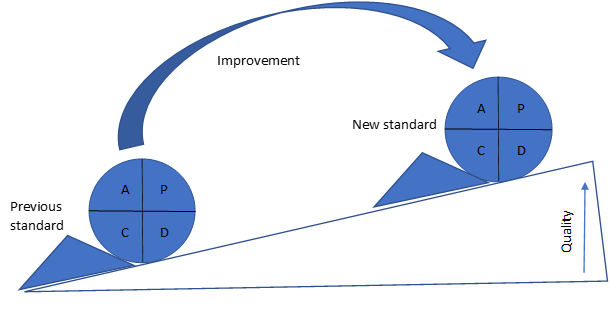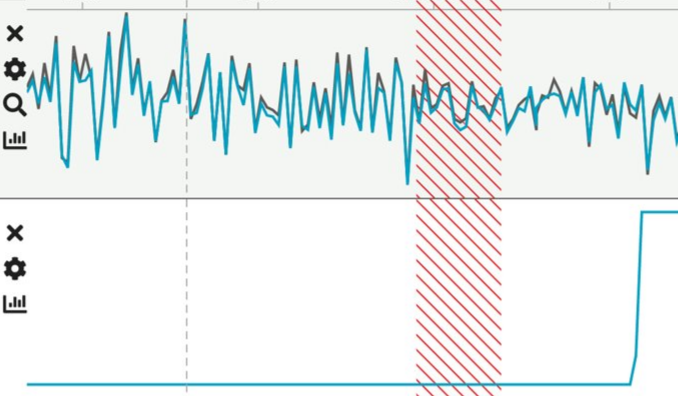Continuous improvement has many different definitions (1), but we will utilize Deming’s (2) definition of “Improve constantly and forever the system of production and service”. There seems to be a link between continuous improvement and quality (3). Also, individual Six Sigma Black Belt improvement projects reach $200,000 in yearly savings (4). Both issues clearly highlight the importance of continuous improvement. Cost savings and improved quality are both achievable by systematic improvement of processes. As such, continuous improvement should be an organization-wide objective.
PDCA-cycle
PDCA-cycle (also known as PDSA-cycle) is one of the most well-known continuous improvement frameworks. While there are plenty of other alternatives (Kaizen, 8D, A3, DMAIC, Juran's Trilogy), all of them follow a similar logic. The PDCA cycle consists of four phases.
In the plan-phase, the personnel spot an improvement opportunity and create an action plan which defines the objectives, steps to take, and planned outcomes for the improvement.
In the do-phase, the personnel conduct the actual experiment as specified in the plan-phase.
In the check (or study)-phase, the personnel estimate how well the improvement opportunity met the objectives. This is based on the data collected during the do-phase.
In the act-phase, the final process improvement happens. The improved process is based on the results from the check-phase. A new standard should be set in place, so the improvement is sustained in the future.
After one cycle, the process should have led to better productivity. The cycle then repeats, creating continuous improvement.

How Factory Harmonizer can aid the PDCA cycle during distinct phases
Factory Harmonizer is an AI-based software solution designed for operators and engineers. Factory Harmonizer brings together the best of human expertise, machinery, and automated machine learning to stabilize the production process for better productivity.
Plan
One of the main functionalities of Factory Harmonizer is to notice disturbances in the process through the Observer -view. The system will highlight potential problems for the operators that can then be troubleshooted by the plant personnel.
Do
Factory Harmonizer itself cannot make changes in the process but it provides a sanity check for the operators before making the actual changes.
Check
The check phase is where Factory Harmonizer also shines. As industrial processes tend to be complex, Factory Harmonizer can highlight what parts of the process are experiencing unexpected behaviour. While operators can follow the suspected changes closely, Factory Harmonizer is expected to highlight unexpected issues that were not on the radar of the personnel.
Act
During the act-phase Factory Harmonizer provides a background to support the operators. After a new model retraining, a new standard is in place. This new standard provides the next stepping stone in the pursuit of improved productivity.
Case example during a whole cycle
In the following section, we provide an example case where Factory Harmonizer was utilized during an improvement cycle. Overall the improvement cycle was relatively fast and took four hours from start to finish.
Plan: During normal plant operations, Factory Harmonizer highlighted significant fluctuations in the dewatering of the lower press felt. The operators visually verified that there were issues in the actual process. The plant personnel estimated that reducing the suction should bring the process back into control.

Do: The personnel dropped the suction by a small amount. It was expected for the fluctuations to be under control after some time.

Check: During the check phase it was evident that the fluctuations came back under control again. It was also important for the personnel to verify that the other press was working correctly at the same time. Through a quick glance at Factory Harmonizer, they saw that there were no significant changes present.

Act: The suction was kept at the lower level for a short while thereafter as no negative consequences from the lower pressure were observed. As the fluctuations were abnormal, the personnel also decided to investigate the piping and pumps involved during the next maintenance.
Enhance your continuous improvement
Continuous improvement is a necessary condition in any factory. Without it, competitors will outrun your factory in regards to productivity. In many cases, specialists run individual improvement efforts in isolation, but with Factory Harmonizer it is possible to have more personnel participating in continuous improvement. Modern digital tools provide support in the pursuit of continuous improvement by providing new insights and efficiency to the process.
Want to hear more about how we at SimAnalytics help factories improve their productivity? Book a call with one of our experts.
Footnotes
- Sanchez, L. and Blanco, B. (2014), “Three decades of continuous improvement”, Total Quality Management & Business Excellence, Vol. 25 Iss 9 - 10
- Deming, W.E. (1982). Out of the crisis. Cambridge, MA: Center for Advanced Engineering Study
- Bhuiyan, N. and Baghel, A. (2005), "An overview of continuous improvement: from the past to the present", Management Decision, Vol. 43 Iss 5
- https://www.isixsigma.com/benchmarking/research-black-belt-return-on-investment/




